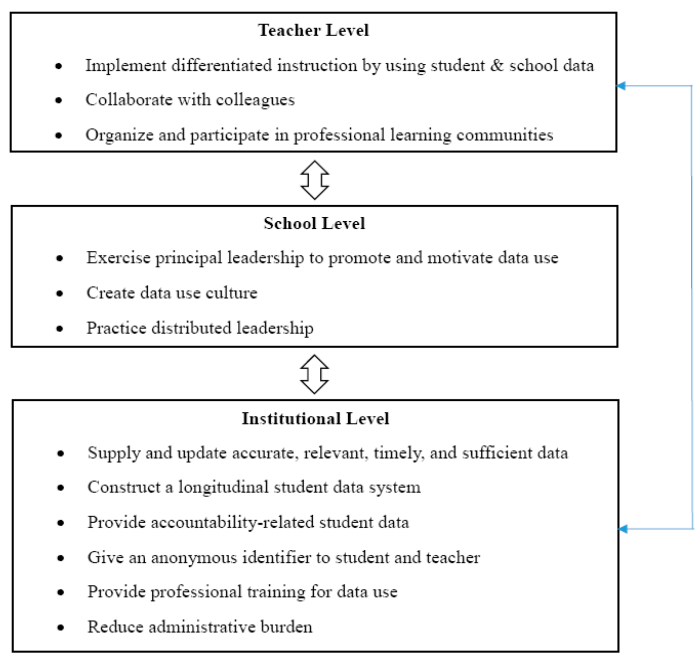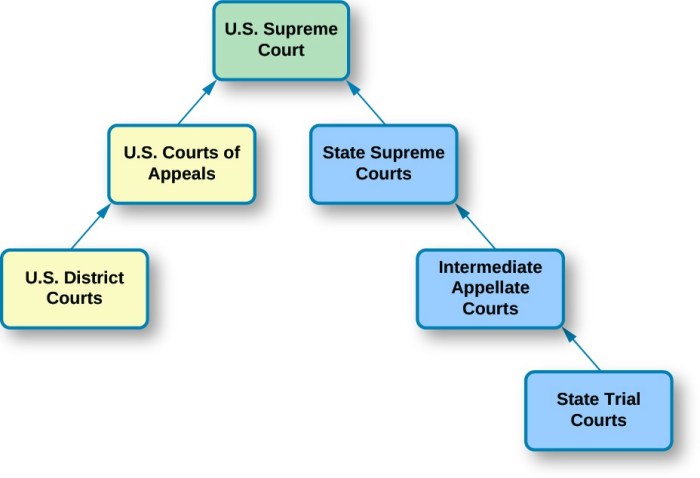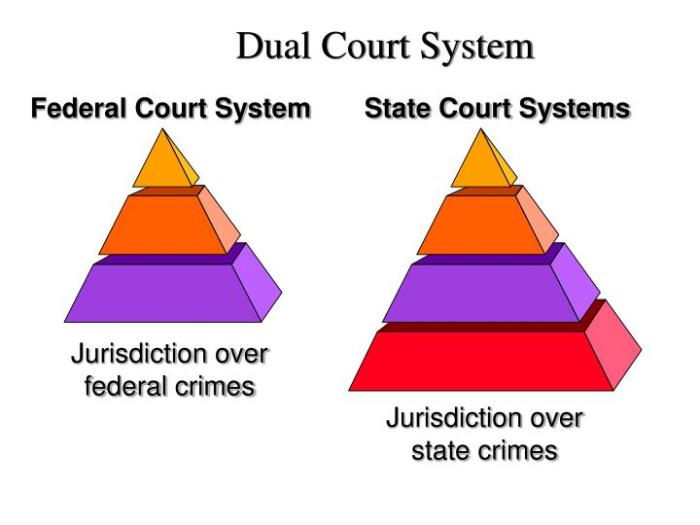Double take: dual court system – In the realm of jurisprudence, where justice reigns supreme, we embark on a captivating journey to unravel the intricacies of the dual court system. This unique judicial landscape presents a fascinating interplay of distinct jurisdictions, structures, and procedures, inviting us to delve into its complexities and explore its profound implications.
Dual court systems, as their name suggests, operate as two separate and parallel judicial entities within a single legal framework. This intriguing arrangement has both ardent proponents and staunch critics, each extolling the virtues or decrying the flaws of this distinctive approach to justice.
Dual Court Systems
A dual court system is a legal system that consists of two distinct sets of courts, each with its own jurisdiction and procedures. The most common type of dual court system is the one that separates civil and criminal cases.
In a civil case, one party is suing another party for damages or other relief. In a criminal case, the government is prosecuting an individual for a crime.
There are a number of countries that have dual court systems, including the United States, the United Kingdom, and Canada. In the United States, the federal courts have jurisdiction over cases involving federal law, while the state courts have jurisdiction over cases involving state law.
In the United Kingdom, the High Court of Justice has jurisdiction over civil cases, while the Crown Court has jurisdiction over criminal cases. In Canada, the provincial courts have jurisdiction over provincial law, while the federal courts have jurisdiction over federal law.
Advantages of Dual Court Systems
- Efficiency:Dual court systems can be more efficient than a single court system because they can specialize in different types of cases. This can lead to faster and more efficient resolution of cases.
- Expertise:The judges in a dual court system are likely to have more expertise in the type of cases they hear. This can lead to better-informed decisions.
- Fairness:Dual court systems can be fairer than a single court system because they can provide different procedures for different types of cases. This can help to ensure that the rights of all parties are protected.
Disadvantages of Dual Court Systems, Double take: dual court system
- Cost:Dual court systems can be more expensive than a single court system because they require two sets of courts and judges.
- Complexity:Dual court systems can be more complex than a single court system because they have different procedures for different types of cases. This can make it difficult for people to understand the legal system and to get the help they need.
- Inconsistent decisions:Dual court systems can lead to inconsistent decisions because the different courts may interpret the law differently. This can make it difficult for people to know what their rights are and how to protect them.
Jurisdiction of Dual Courts

Dual court systems divide jurisdiction between two separate court systems, typically based on the nature of the case. Each court system has its own set of rules and procedures.
Double take: dual court system pits one court against another, leading to confusion and inconsistency. Plato’s allegory of the cave questions echoes this dilemma, where prisoners chained in a cave can only see shadows projected on the wall, mistaking them for reality.
Similarly, our limited perspective in the dual court system may lead us to accept superficial rulings without questioning their underlying flaws, perpetuating the shadows rather than seeking the true light of justice.
Jurisdiction is the authority of a court to hear and decide cases. In dual court systems, jurisdiction is divided between the two court systems based on the subject matter of the case, the amount of money in dispute, or the type of relief being sought.
Federal Courts
Federal courts have jurisdiction over cases that involve federal law, including cases involving the Constitution, federal statutes, and treaties. Federal courts also have jurisdiction over cases involving diversity of citizenship, where the parties are from different states and the amount in dispute exceeds a certain amount.
State Courts
State courts have jurisdiction over cases that involve state law, including cases involving contracts, torts, property disputes, and family law. State courts also have jurisdiction over cases involving crimes that are committed within the state.
Structure and Organization of Dual Courts

Dual court systems consist of two distinct court systems: one for general civil and criminal cases, and the other for specific types of cases, such as family law, probate, or juvenile justice. Each system has its own structure, organization, and hierarchy of courts.
Hierarchy of Courts
The hierarchy of courts within each system varies from jurisdiction to jurisdiction. However, a typical structure may include the following levels:
- Trial courts: These courts handle the initial proceedings and trials of cases.
- Intermediate appellate courts: These courts review decisions made by trial courts.
- Supreme court: This is the highest court in the jurisdiction and has the final say on all legal matters.
Roles and Responsibilities of Judges and Court Officials
Judges are responsible for presiding over trials, making rulings on legal issues, and imposing sentences. Other court officials, such as clerks, bailiffs, and court reporters, assist the judge in managing the court and ensuring that proceedings are conducted fairly and efficiently.
Procedural Differences in Dual Courts
Dual court systems often exhibit procedural differences that impact the handling of cases. These variations can include distinct rules governing discovery, trial procedures, and evidence admissibility. Understanding these procedural differences is crucial for legal practitioners and parties involved in cases within dual court systems.
Discovery Rules
Discovery refers to the process of exchanging information between parties in a legal case. In dual court systems, the rules governing discovery may differ significantly. One court system may adopt a broad approach to discovery, allowing parties to obtain a wide range of documents and information.
In contrast, the other court system may have more restrictive discovery rules, limiting the scope of information that can be exchanged. These differences can have a substantial impact on the preparation and presentation of cases.
Trial Procedures
Trial procedures can also vary between dual court systems. For instance, one court system may utilize a jury trial as the default method of resolving disputes, while the other court system primarily employs bench trials, where a judge or panel of judges decides the case.
Additionally, the rules governing the presentation of evidence, the examination of witnesses, and the instructions given to the jury or judge can differ between the two court systems.
Evidence Admissibility
The rules governing the admissibility of evidence can also vary in dual court systems. One court system may have stricter rules regarding the admissibility of certain types of evidence, such as hearsay or expert testimony. In contrast, the other court system may have more lenient rules, allowing for the admission of a broader range of evidence.
These differences can significantly impact the outcome of cases, as the availability of admissible evidence can influence the strength of a party’s case.
Case Flow in Dual Courts: Double Take: Dual Court System

The flow of cases through dual court systems is a complex process that can vary depending on the jurisdiction. However, there are some general stages that are common to most dual court systems.
The first stage is the filing of a complaint. The complaint is a legal document that sets out the plaintiff’s (the person who is suing) claims against the defendant (the person being sued). Once the complaint is filed, the defendant is served with a summons, which informs them of the lawsuit and requires them to file an answer.
The next stage is the discovery process. During discovery, the parties exchange information about the case. This can include interrogatories (written questions that the parties must answer), requests for production of documents, and depositions (oral examinations of the parties and witnesses).
Once discovery is complete, the case proceeds to trial. The trial is a hearing before a judge or jury, where the parties present their evidence and arguments. After the trial, the judge or jury will issue a verdict, which is a decision on the merits of the case.
If the verdict is in favor of the plaintiff, the court will enter a judgment, which is a legal order that requires the defendant to pay damages or take some other action. The defendant may appeal the judgment to a higher court.
Factors Affecting the Length and Complexity of the Process
The length and complexity of the case flow process can be affected by a number of factors, including:
- The complexity of the legal issues involved
- The amount of discovery that is required
- The number of parties involved
- The availability of resources
- The willingness of the parties to settle
Criticisms and Reforms of Dual Court Systems

Dual court systems have been criticized for creating a complex and inefficient judicial system. Critics argue that it can lead to inconsistent rulings, delays, and increased costs for litigants. Additionally, some critics contend that dual court systems can perpetuate social and economic inequalities by providing different levels of access to justice for different groups of people.
Proposed Reforms
Several reforms have been proposed to address these criticisms. One common proposal is to merge the two court systems into a single, unified system. This would eliminate the potential for inconsistent rulings and reduce delays and costs. Another proposal is to create specialized courts to handle specific types of cases, such as family law or commercial disputes.
This would allow judges to develop expertise in particular areas of law and provide more efficient and effective adjudication.
Examples of Reforms
Several countries have implemented reforms to their dual court systems. For example, in 1971, England and Wales merged their common law and equity courts into a single High Court of Justice. In 1997, Australia created the Federal Circuit Court of Australia to handle family law and other federal matters.
These reforms have been successful in reducing delays, costs, and inconsistencies in the judicial system.
Essential FAQs
What is the primary purpose of a dual court system?
Dual court systems are designed to separate the handling of specific types of cases, such as civil and criminal matters, or to cater to different levels of legal complexity.
How does jurisdiction differ between the two courts in a dual court system?
Jurisdiction is typically divided based on the nature of the case, the severity of the offense, or the geographical location.
What are the key procedural differences between dual court systems?
Procedural differences may include variations in discovery rules, trial procedures, and the roles of judges and juries.